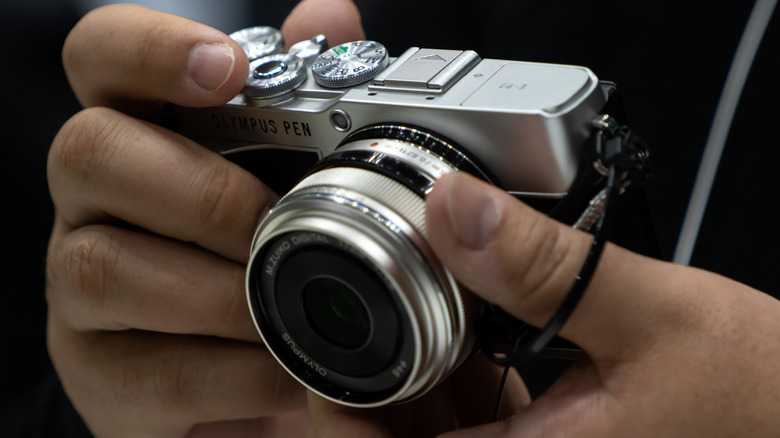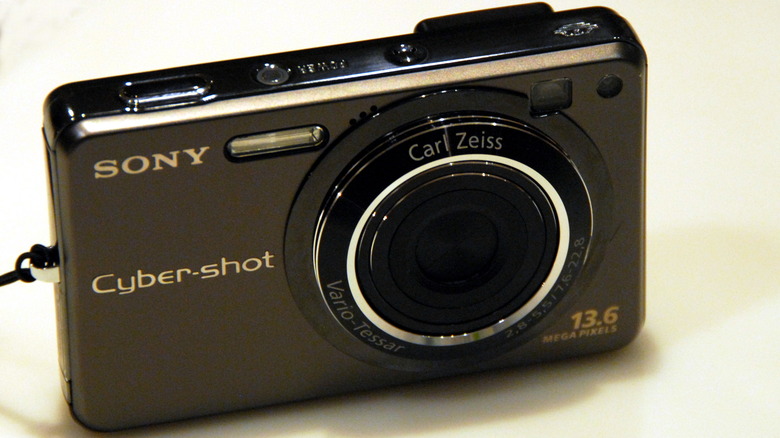Old Digital Cameras Are TikTok's New Favorite Craze, But Are They Really Worth It?
TikTok's popularity has led to an explosion of popular trends within youth culture, and fears over it's ability to spread misinformation have even led to a possible TikTok ban in the United States. Amid an algorithmic churning of phases and fads, 32% of young adults now say their news comes from the app, and it also explains why a great number of them are currently obsessed with point-and-shoot digital cameras from the turn of the millennium. Viral videos feature young adults showing off cameras from brands like Olympus, Sony, and Kodak. Meanwhile, a cottage industry of newly made "retro" cameras has emerged.
Yes, shop-fluencers — people who hawk goods on TikTok — have begun pushing "digicams" as a way of regaining analog control over a life that, for young people, has been mostly digital. In one video by @nateslife4, for example, viewers are told that a cheap point-and-shoot camera of the sort is a way to impart new photos with a vintage feel. Without directly claiming the cheap camera he's selling can replicate the feel of film photos, the user points out the various filters available on the camera's operating system will help take "vintage photos."
However, those thinking of jumping in on this nostalgic TikTok craze should be aware that these types of cameras have some severe limitations. Ultimately, those craving a dose of the old days may be better off buying a real film camera or sticking with their smartphone. Here's what to know before jumping on the digicam bandwagon.
Cheap, old digital cameras have cheap, old quality
Many of the "digicam" style cameras that are most often featured in wistful TikTok videos shoot significantly worse photos than the smartphone in your pocket. Most use CCD (charge-coupled device) sensors, a technology developed as an early digital imaging method. It involves letting the pixels of a sensor array get bombarded by light photons, which are then shifted one after another until they reach an amplifier and are converted to an electrical signal.
CCD tech has largely been usurped by CMOS (complementary metal-oxide semiconductor) technology, which is more efficient as it allows each pixel to be individually amplified while reducing noise, leading to adoption even by Canon EOS. Moreover, many older and cheaper CCD cameras have low quality sensors, with many having around 4-8 megapixels. Although CCD is technically capable of more high-quality imaging, consumer grade technology rarely contains better sensors since they draw a great deal of power to operate.
The claim that 2000s-era handheld cameras will produce more "vintage" photos is, of course, true from the perspective that the photos will look outdated — but untrue if you desire an image closer to film quality. While exposing a digital sensor to light seems similar to exposing film, those similarities end after the light touches the pixels and gets transformed into an electrical signal. Old digital cameras are also likely to be worse in low light without a flash, and they usually lack modern features like image stabilization.
You can digitally mimic film on your smartphone
If you want a more film-like look on the photos you take, you can always buy a film camera. Film photography is another rising trend among young people, and one with aesthetic benefits over digital photography of any kind. But those joining the point-and-shoot trend likely enjoy sharing their photos digitally and are searching for a middle ground. For adding a retro feel to your digital photos, you can always grab a program like Darkroom that has a variety of features and filters to mimic the film grain of expensive film cameras like Leica's shooters. Even the built-in suite of photo editing tools on most smartphones will have some film filters, or you could use an app like VSCO, which is built to mimic classic film cameras.
But many young people who have adopted the point-and-shoot life aren't in it for the photo quality. In interviews with the BBC, they explained that they're drawn to the older, tactile feeling of the hardware, such as the mechanical zoom. They also like the look of CCD photos on their own terms, oftentimes preferring low-end hardware that produces grainy, technically "bad" photos, saying it reminds them of childhood. And since the age demographic most invested in this trend appear to be young adults who would have been children when point-and-shoot cameras were popular, that makes a lot of sense.
Old point-and-shoot cameras are a headache to use
Lastly, it's worth pointing out that the old point-and-shoots currently in vogue among Gen Z and Gen Alpha on TikTok are a headache to use in 2024. They often have proprietary ports that require specific cables, connectors, and chargers, and even media cards that are no longer available — like the Memory Stick standard once favored by Sony's Cyber-Shot cameras.
Buying such cameras second-hand could bite you if the device shows up missing those unique cables. And if you manage to find a brand-new camera in its original packaging, many of the cables will likely have vulcanized by now, meaning they've decomposed. Even should you get lucky and find a unit with cables intact, you'll need to track down and purchase one of those defunct storage mediums. That's a lot of work to put into owning a camera that probably pales in comparison to the one built into your phone.
@_caitlin.mcc gimme a minute pookie #fyp #foryou #camerafriend #digitalcamera #sonycybershot
However counterintuitive, those headaches seem to be part of the appeal for the TikTok users who've joined the digicam trend. One video, posted by @_caitlin.mcc, demonstrates the process of transferring her photos from a Sony Cyber-Shot to a MacBook via an archaic, proprietary connector. The caption layered over the footage reads, "'can u send the pics from last night?'" The extra steps are transformed in this context into a way of stepping back in time. Perhaps, in a world of seamless technology, the added friction becomes an act of protest against the relentless march of time.
[Featured image by Bordgious via Wikimedia Commons | Cropped and scaled | CC BY-SA 3.0]



